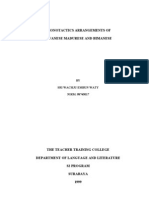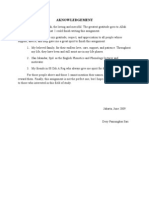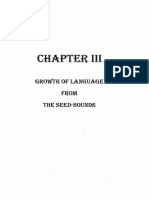SVBF Sanskrit 01
SVBF Sanskrit 01
Uploaded by
dgraghavCopyright:
Available Formats
SVBF Sanskrit 01
SVBF Sanskrit 01
Uploaded by
dgraghavCopyright
Available Formats
Share this document
Did you find this document useful?
Is this content inappropriate?
Copyright:
Available Formats
SVBF Sanskrit 01
SVBF Sanskrit 01
Uploaded by
dgraghavCopyright:
Available Formats
An Introduction to Sanskrit
Page 1 of 5
An Introduction to Sanskrit
by: M. R. Dwarakanath
Preface: The following is a general interest article on Sanskrit and is not intended to be the 1st lesson on the subject. The actual lessons will start with the next issue of this journal. The lessons will assume the reader to be familiar with the Nagari script and not much more about Sanskrit. Each lesson will be divided into a number of topics like Conversational Sanskrit, Popular Slokas, Vocabulary, Grammar and other material. The key to gaining a working knowledge of Sanskrit is patience; keep reviewing the old material with each new lesson and soon the rewards will become apparent. To be able to make sense out of written Sanskrit is to be able to break a word cluster into its constituent words, a process called pdzed, and to recognize the parts of speech. To this end minimal grammar will be introduced. However, the grammar will pay big dividends! Finally, the author acknowledges he is no sanskritist but merely a lay enthusiast, playing the role of a facilitator. He requests your indulgence for the many gaffs and errors to be found in these lessons and welcomes your drawing his attention to them. Invocation
Nruttaavasaane Nataraajaraajaha nanaada dhakkaam navapancavaaram Uddhartu kaamassanakaadi siddhaan etadvimarse Sivasootrajaalam At the conclusion ( dance ( and five ( that ( ) times ( ) web ( ). Sanskrit Language: Sanskrit ( properly ( ) crafted ( ) means ) of the cosmic dance ( ) his double drum ( ) like Sanaka et. al. ( ) with the aim of ( ) the lord of ) nine ( ) ) up-lifting ( ). It is ) I wish to
) sounded (
) accomplished souls ( examine (
) of Lord Sivas aphorisms (
) or a refined (grammatically)
language. It is regarded as the language of the Gods. Indeed it is believed that the phonology of all speech was created when Lord Nataraaja sounded his double drum as in the above invocation. Panini was a grammarian par excellence. Although many
file://C:\journal\vol1no1\sanskrit.html
9/7/2007
An Introduction to Sanskrit
Page 2 of 5
grammarians preceded Panini, they are all but forgotten because of Paninis stature much as Shakespeare and Newton eclipsed their predecessors. Panini was considered to be a dull lad, and he ran away from home and practiced severe penance. Lord Siva, pleased by Paninis austerities appeared before him and sounded the drum nine and five or fourteen times. Panini became instantly learned by the grace of the Lord. The sound of Sivas drums transformed Panini into a gifted scholar and this sound contains all the alphabets of Sanskrit and are called Siva Sutras. Sivasootrani
Sivasootrani: When the Siva Sutras are recited with appropriate diction, they do indeed sound like a drum roll. These Siva Sutras play an extremely important role in the study of Sanskrit grammar. The sounds are arranged in a unique pattern and the sounds that are close together in the Siva Sutras are also close to one another phonologically. Panini creates from the Siva Sutras a shorthand notation for alphabet clusters in the following manner: 1. Ignore the final member of each line of the sutras. 2. A group of phonologically related sounds are then
file://C:\journal\vol1no1\sanskrit.html
9/7/2007
An Introduction to Sanskrit
Page 3 of 5
abbreviated by the 1st and last members of the group forming a one syllable shorthand notation. 3. The last member can be (usually is) the last member of any line. Examples: includes: - these are the simple vowels. ) taking one unit of ) are implicitly . The long vowels take two units represents all vowels including and ) or includes the harsh ( ), etc.
Although these are short vowels ( prosodical time, the long vowels ( included. Only there is no long of time to enunciate. Similarly, represents the consonants, un-voiced consonants,
diphthongs or conjunct vowels. The diphthongs are the fricatives (
The Siva Sutras show the grand phonology of the language, yet provide a utilitarian tool to concisely name groups of similar sounds. As we will be returning frequently to Siva Sutras in the study of Sanskrit, it would be well worth the effort to memorize them. - The Alphabets: literally means a garland of letters or characters. The standard organization of the alphabets include : 9 simple vowels, 4 diphthongs, and 33 consonants for a total of 48 characters. This arrangement is well known to readers. Here we arrange the same characters in a slightly different pattern to both display the scientific and mathematical beauty as well for the utility this arrangement affords.
1. The 1st column lists the points of articulation of sound in the vocal apparatus. There are 5 such points : or guttural (throat), or palatal / velar (sound produced with tongue in
file://C:\journal\vol1no1\sanskrit.html
9/7/2007
An Introduction to Sanskrit
Page 4 of 5
contact with the soft palate),
or cerebral (tongue in contact
with the roof of the mouth), or dental (tongue in contact with the back of the teeth), and finally or labial (the lips coming together). 2. The 2nd column lists the 3. The 3rd column lists the or short vowels. or long vowels.
4. Column 4 lists the or unaspirated, unvoiced consonants. Aspiration involves an explosive gush of air released when the sound is produced. Voicing involves the vibration of vocal chords. Neither occurs for this group of sounds. 5. Column 5 lists the consonants. 6. Column 6 lists the consonants. 7. Column 7 lists the consonants. or the aspirated, unvoiced
or the unaspirated, voiced
or the aspirated, voiced
8. Columns 8, 9 and 10 list respectively the the or the semi-vowels and the
or the nasals, or the fricatives.
The mathematical and scientific beauty alluded to earlier may be seen by the logical organization of sounds into a nearly complete matrix by function of the vocal apparatus. This table will greatly facilitate understanding the various sandhi rules and may be worth memorizing the table in this form.
Vowels
: Hrsva, Deergha, Guna and Vrdhi: Although we have seen 13 vowel sounds, they are based on 5 basic vowel sounds. The rest are composite vowels. For now we will introduce the concept of Guna and Vrdhi as a process of strengthening the vowels. How precisely this is done will be seen in a later lesson.
file://C:\journal\vol1no1\sanskrit.html
9/7/2007
An Introduction to Sanskrit
Page 5 of 5
By examining the following pairs of words: ( ), ( ), ( initial vowel of the 1st member of a pair takes second member - a derivative word! Suggested Books:
), ( to form the
), we can see how the
Devavaani Pravesika - Robert Goldman and Sally Sutherland, University of California, Berkeley First / Second Book of Sanskrit - R. G. Bhandarker Karnatak Publishing House, Bombay
Dr. M. R. Dwarakanath has been teaching Introductory Sanskrit for a few years in New Jersey. By profession, he is a scientist in Bell Laboratories. He has a keen interest in vedic learning and vedanta.
file://C:\journal\vol1no1\sanskrit.html
9/7/2007
You might also like
- Samskrtasubodhini. A Sanskrit Primer. (M.deshpande) (2007)Document471 pagesSamskrtasubodhini. A Sanskrit Primer. (M.deshpande) (2007)sktkoshas94% (49)
- Guide (Sanskrit)Document95 pagesGuide (Sanskrit)Guruprasad Bhatta100% (7)
- The Musical Aspects of the Ancient Egyptian Vocalic LanguageFrom EverandThe Musical Aspects of the Ancient Egyptian Vocalic LanguageRating: 4 out of 5 stars4/5 (2)
- Guide SanskritDocument95 pagesGuide Sanskritjatin.yadav1307No ratings yet
- Elementary Pali CourseDocument53 pagesElementary Pali Coursejorge_lazaro_6100% (1)
- Shahsavari A., Atwood B. - Persian of Iran Today. An Introductory Course. Units 11-15 - 2015 PDFDocument165 pagesShahsavari A., Atwood B. - Persian of Iran Today. An Introductory Course. Units 11-15 - 2015 PDFdieterNo ratings yet
- The SyllableDocument10 pagesThe Syllableسہۣۗيزار سہۣۗيزارNo ratings yet
- Narada S Elemenary Pali CourseDocument69 pagesNarada S Elemenary Pali Courseනන්දන වඩුතන්තිරිNo ratings yet
- Phonotactics ArrangementsDocument14 pagesPhonotactics ArrangementsRhazes Avicenna0% (1)
- A Typological Description of Modern Mandarin ChineseDocument21 pagesA Typological Description of Modern Mandarin ChineseTai Lam100% (1)
- Siva Sutra PaperDocument16 pagesSiva Sutra PaperShivaram Reddy ManchireddyNo ratings yet
- Bhaktivedanta Academy SyllabaryDocument47 pagesBhaktivedanta Academy SyllabaryPedro RamosNo ratings yet
- Assignment IIIDocument13 pagesAssignment IIIsoraisfranciscovalentimNo ratings yet
- A Typological Description of Modern Mandarin Chinese - by Tai LamDocument20 pagesA Typological Description of Modern Mandarin Chinese - by Tai LamTai LamNo ratings yet
- A Typological Description of Modern Mandarin ChineseDocument20 pagesA Typological Description of Modern Mandarin ChineseLamnguyentai100% (1)
- A Paper of Phoenetic and PhonologyDocument14 pagesA Paper of Phoenetic and PhonologyZakiah KhyNo ratings yet
- Panini Vyakaran LettersDocument15 pagesPanini Vyakaran LettersManju GuptaNo ratings yet
- Speech SoundsDocument31 pagesSpeech SoundsAnthony Gio L. AndayaNo ratings yet
- Makalah EppDocument12 pagesMakalah Eppdesys_4100% (1)
- A Handbook On English Grammar and WritingDocument36 pagesA Handbook On English Grammar and WritingSagar KathiriyaNo ratings yet
- IntroductiontoSanskritComplete PDFDocument138 pagesIntroductiontoSanskritComplete PDFeswari ayyaswamy100% (1)
- Saraswati RiverDocument258 pagesSaraswati Riverapi-27469451100% (2)
- 10 - Chapter 4Document33 pages10 - Chapter 4indoNo ratings yet
- A Concise Introduction To The Amdo DialeDocument20 pagesA Concise Introduction To The Amdo DialeJason Franklin100% (1)
- Phonology-Orthography Interface in Devanāgarī For Hindi : 2nd ProofsDocument9 pagesPhonology-Orthography Interface in Devanāgarī For Hindi : 2nd ProofsAneesh WairagadéNo ratings yet
- Help-IPA For SanskritDocument2 pagesHelp-IPA For Sanskritcastro5017No ratings yet
- Day I - Introduction To Phonetic and PhonologyDocument44 pagesDay I - Introduction To Phonetic and Phonologynatalia anggrariniNo ratings yet
- Taha and Waw The Universal Methods of WRDocument10 pagesTaha and Waw The Universal Methods of WRSergio PetrussaNo ratings yet
- El1oo Module 3Document9 pagesEl1oo Module 3Cherry DerramasNo ratings yet
- Sankhyakarika.: Evidence That Tamil Must Have Been Derived From SanskritDocument3 pagesSankhyakarika.: Evidence That Tamil Must Have Been Derived From Sanskritraman73No ratings yet
- Cartilla LLD IDocument127 pagesCartilla LLD IkarinaNo ratings yet
- Transliteration Involving English and Hindi Languages Using Syllabification ApproachDocument32 pagesTransliteration Involving English and Hindi Languages Using Syllabification ApproachPawan KumarNo ratings yet
- النحو التحويليDocument26 pagesالنحو التحويليAbu EdwardNo ratings yet
- Sanskrit Diacritics PDFDocument6 pagesSanskrit Diacritics PDFelfboy1999No ratings yet
- Specialities of Sanskrit Language and LiteratureDocument5 pagesSpecialities of Sanskrit Language and LiteratureAnupama RaoNo ratings yet
- Introduction To SanskritDocument152 pagesIntroduction To Sanskritnotuarca100% (1)
- The Influence of Dravidian On Indo AryanDocument8 pagesThe Influence of Dravidian On Indo Aryansuenpui lammNo ratings yet
- Introductiontopr 00 WoolrichDocument248 pagesIntroductiontopr 00 WoolrichАнтон Коган100% (2)
- Basic Course in Spoken NepaliDocument284 pagesBasic Course in Spoken Nepaliromanmystery100% (2)
- English Grammar and WritingDocument35 pagesEnglish Grammar and WritingDhivyaNo ratings yet
- CBR Bahasa InggrisDocument8 pagesCBR Bahasa InggrisAzrun NstNo ratings yet
- Indian English ProsodyDocument32 pagesIndian English ProsodyChinh DangNo ratings yet
- Teaching Resources - Poems and Songs - 10dec2007Document37 pagesTeaching Resources - Poems and Songs - 10dec2007Bily ManNo ratings yet
- Secret of Sankhya: Acme of Scientific Unification: Sanskrit LanguageDocument4 pagesSecret of Sankhya: Acme of Scientific Unification: Sanskrit LanguageAni VinNo ratings yet
- A Syntactical Analysis On Sentence Structure Used in Two Adeles'S SongsDocument14 pagesA Syntactical Analysis On Sentence Structure Used in Two Adeles'S SongsRudy MunawwirNo ratings yet
- India Latin: SANSKRPT, The Name Applied by Hindu Scholars To The Ancient Literary Language ofDocument95 pagesIndia Latin: SANSKRPT, The Name Applied by Hindu Scholars To The Ancient Literary Language ofMax BatlleNo ratings yet
- Indo-Aryan and SlavicDocument8 pagesIndo-Aryan and SlavicscridownloadNo ratings yet
- Problems With PhonemesDocument6 pagesProblems With PhonemesAnwar KhanNo ratings yet
- Introduction in SanskritDocument2 pagesIntroduction in SanskritDrago LicansNo ratings yet
- Week 1: Mythology and Folklore English Class Professor: John Michael CulturaDocument7 pagesWeek 1: Mythology and Folklore English Class Professor: John Michael CulturaMichaels CulturaNo ratings yet
- G4-Makalah ItoL PhoneticsDocument21 pagesG4-Makalah ItoL Phoneticsppg.evisyafitri03130No ratings yet
- DVP L4 NotesDocument19 pagesDVP L4 NotesjjitNo ratings yet
- Linguistics Question AnswerDocument8 pagesLinguistics Question AnswerAnonymous v5QjDW2eHxNo ratings yet
- Grammatical Units and ProcessesDocument20 pagesGrammatical Units and ProcessesThamiah Izabell OdenaNo ratings yet
- Language and Linguistics Bit ( ʖ )Document2 pagesLanguage and Linguistics Bit ( ʖ )Krishna PriyaNo ratings yet
- Portuguese Grammar for Beginners 1: Portuguese Grammar for Beginners, #1From EverandPortuguese Grammar for Beginners 1: Portuguese Grammar for Beginners, #1No ratings yet
- Korean in a Hurry: A Quick Approach to Spoken KoreanFrom EverandKorean in a Hurry: A Quick Approach to Spoken KoreanRating: 2 out of 5 stars2/5 (1)



























































